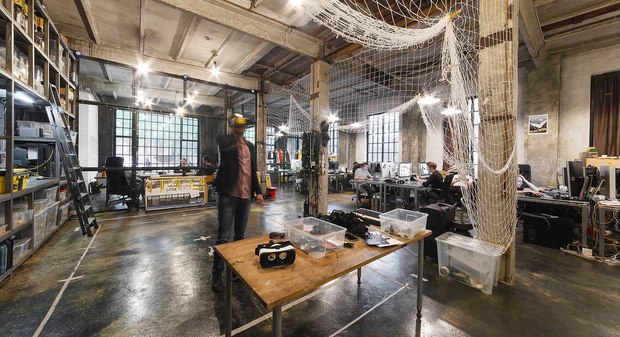Russian studio integrates Samsung Gear VR technology and OptiTrack mocap cameras and motion tracking software with an in-house server and custom mobile applications to deliver wireless virtual environments.
Working Wirelessly
In producing VR projects, Interactive Lab discovered early on that giving participants the freedom to navigate a virtual environment without wires or controls would make for a more engaging and realistic experience. Combining state-of-the-art motion capture tools for low latency 6DoF 3D tracking and wireless HMD technology, Interactive Lab created “Move in VR” – a proprietary solution that integrates Samsung Gear VR technology and OptiTrack mocap cameras and motion tracking software with an in-house server and custom mobile applications. The combination facilitates a wireless experience by tracking global XYZ translation through the OptiTrack system and the rotational tracking through the headsets’ built-in sensors, typically in a 30-70 square meter volume.
Interactive Lab Producer Vlad Novikov explained, “Move in VR has not only increased the stability of our VR apps, but made it easier than ever to create an independent ecosystem in which the viewer can comfortably dive deep into VR, which just wasn’t possible before with wires and external controls.”Real-Time Data
To increase app stability, Interactive Lab uses a middle server in the system. The server receives the raw data, parses the global space coordinates and distributes them to the smartphone app through Wi-Fi; head rotation tracking is processed by Samsung Gear VR’s gyroscope. The server setup also minimizes the delays that can occur when sending data wirelessly for a more pleasant immersive experience.
“Using OptiTrack not only provides us with precise positional tracking at up to 240fps but we’re also able to do so in large volumes and in rooms with reflective materials. Our system is portable, affordable, easy to set up and has awesome specs for what we’re doing,” noted Novikov.
Beyond Entertainment
As Interactive Lab continues to develop "Move in VR," it's uncovering new applications daily - from real-estate to business, architecture and interior design, theme parks, photogrammetry and beyond. The team recently developed a VR demo that would allow real-estate sales offices to show clients how their future apartments/houses/offices might look and feel. Once in the space, clients can move through various rooms and ask the sales manager to make design changes, for instance the wallpaper, which they can see implemented in real-time. Interactive Lab's team also showcased the capabilities of "Move in VR" in creating a virtual art gallery that could be used to showcase nearly any exhibition in VR. Moreover, they've created various painting tools to let artists express their own style for the Russia's first exhibition in 2 realities.
Source: Interactive Lab









